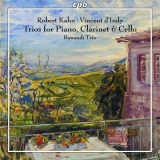Robert Kahn war für die Nazis ein ‘Entarteter’, ein jüdischer Komponist, dem aber die Flucht nach England gelang. Wie so mancher seiner Kollegen war er nach dem Krieg ein Vergessener.
1865 in Mannheim geboren, 1951 in Biddenden, Grafschaft Kent, gestorben, komponierte Robert Kahn eigentlich nur im Zweitberuf. Er war in erster Linie Pädagoge, und zu seinen bekanntesten Schülern in Musiktheorie und Komposition gehörten die Pianisten Wilhelm Kempff und Arthur Rubinstein, der Dirigent Ferdinand Leitner, die Komponisten Günter Raphael und Nikos Skalkottas sowie der Geiger Karl Klingler. Am Klavier war er der Kammermusikpartner und Begleiter von Musikern wie Joseph Joachim, Adolf Busch und Emmy Destinn.
Kahn hat vier Klaviertrios komponiert sowie das Klarinetten-Trio op. 45. Dieses haben die Musiker des neu gegründeten Klarinettentrios Bawandi, Mario Häring, Alexandre Castro-Balbi und Patrick Hollich, jetzt aufgenommen. Kahn komponierte es für den Klarinettisten Richard Mühlfeld, der bereits Johannes Brahms zu dessen Klarinettenkammermusik inspirierte.
Das Trio ist ein phantasievolles, wunderbar melodisches Stück, das mit einem charakteristischen Allegro beginnt, das vom Bawandi Trio sehr flüssig und oft auch drängend gespielt. Die klug angewandten Tempoveränderungen, das Abbremsen und Anziehen, geben der Musik viel kommunikative Kraft. Dabei fällt auch die wohlige Wärme im Spiel des Klarinettisten und des Cellisten, vor allem im Allegretto quasi andantino auf.
Das abschließende Presto bekommt wieder einen drängenden Charakter, diesmal in Verbindung mit einem direkt tänzerischen Elan, der hin und wieder auch etwas düster eingefärbt ist. Eine großartige mitreißende Interpretation!
Das Ensemble spielt auch das Trio von Vincent d’Indy (1851-1931) feinfühlig, romantisch, poetisch und macht aus der wenig bekannten Partitur erstklassige Musik.
Das Trio op. 29 aus dem Jahr 1888 ist eigentlich sehr gut komponiert. D’Indy, dessen Hauptinstrument das Klavier war, konnte auch Cello und Klarinette spielen, und dieses Talent lässt diese Komposition besonders wirkungsvoll werden. Der viertelstündige Eröffnungssatz wird vom Bawandi Trio sehr stimmungsvoll gespielt, ist aber auch, wenn angebracht, dramatisch und vorwärts drängend. Der zweite Satz, Divertissement, ist ein attraktives und hier sehr inspiriert lustiges Scherzo, das mit vielen rhythmischen Überraschungen aufwartet. Es folgt ein schöner Chant élégiaque, den das Bawandi Trio mit einem sehr ruhigen und verträumten Musizieren attraktiv werden lässt.
Das verspielte und kraftvolle Finale hat viel Elan, bietet aber im Laufe des Stücks auch viele andere Stimmungen, etwa wenn die Atmosphäre vor der fröhlichen Coda komplette kippt und todtraurig wird.
Robert Kahn was a ‘degenerate’ for the Nazis, a Jewish composer who managed to escape to England. Like many of his colleagues, he was forgotten after the war.
Born in Mannheim in 1865, died in Biddenden, County Kent, in 1951, Robert Kahn actually composed only as a second profession. He was primarily a pedagogue, and his best-known students in music theory and composition included the pianists Wilhelm Kempff and Arthur Rubinstein, the conductor Ferdinand Leitner, the composers Günter Raphael and Nikos Skalkottas, and the violinist Karl Klingler. At the piano, he was the chamber music partner and accompanist of musicians such as Joseph Joachim, Adolf Busch, and Emmy Destinn.
Kahn composed four piano trios as well as the clarinet trio op. 45, which the musicians of the newly formed clarinet trio Bawandi, Mario Häring, Alexandre Castro-Balbi and Patrick Hollich, have now recorded. Kahn composed it for the clarinetist Richard Mühlfeld, who had already inspired Johannes Brahms to write his clarinet chamber music.
The trio is an imaginative, wonderfully melodic piece that opens with a characteristic allegro, played very fluidly and often urgently by the Bawandi Trio. The cleverly applied tempo changes, slowing down and picking up, give the music much communicative power. The comforting warmth in the playing of the clarinetist and cellist is also striking, especially in the Allegretto quasi andantino.
The concluding Presto again takes on an urgent character, this time in connection with a directly dance-like élan, which is now and then also somewhat somberly colored. A great, outstanding interpretation!
The ensemble also plays the Trio by Vincent d’Indy (1851-1931) sensitively, romantically, poetically, making first-rate music out of the little-known score.
The Trio, Op. 29, from 1888, is actually very well composed. D’Indy, whose main instrument was the piano, could also play the cello and clarinet, and this talent makes this composition particularly effective. The opening quarter-hour movement is played very atmospherically by the Bawandi Trio, but is also dramatic and urgent when appropriate. The second movement, Divertissement, is an attractive and here very inspired, fun scherzo with many rhythmic surprises. It is followed by a lovely Chant élégiaque that the Bawandi Trio makes attractive with some very quiet and dreamy music-making.
The playful and powerful finale has a lot of verve, but also offers many other moods in the course of the piece, such as when the atmosphere tips completely before the joyful coda and becomes deadly sad.
























